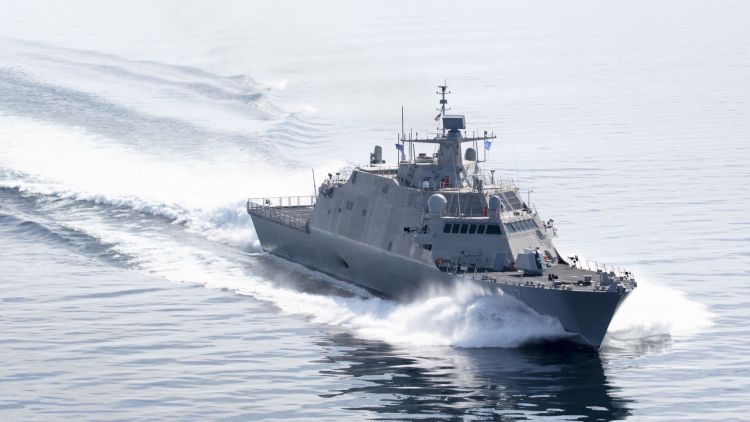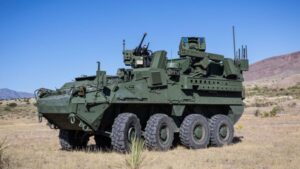The following piece first appeared on Warrior Maven, a Military Content Group member website.
The controversial and long-criticized US Navy Littoral Combat Ship (LCS) vessel appears to have proven its ability to add substantial tactical and maritime warfare support to ongoing warfare operations in the Middle East, something which is, of course, relevant to the Navy’s ongoing thinking regarding plans for its LCS fleet.
An interesting US Navy essay describing the homecoming of the USS Indianapolis (LCS-17), a Freedom-class variant of the LCS, describes how the ship performed combat critical diplomatic, logistical, communications, and navigational functions during US Navy combat against Houthis in the 5th-fleet area of responsibility in the Middle East.
“As the workhorse of the Arabian Gulf, Indy executed the lower tier missions necessary to maintaining good diplomatic relations in the Middle East which allowed Standard Missile shooters to reposition to deal with bad actors in the Red Sea. I think it’s pretty special that we were able to provide the 5th Fleet commander with more tools and options to aid in the free flow of commerce through a contested waterway,” Cmdr. Matthew Arndt, USS Indianapolis‘ Commanding Officer, said in a Navy essay.
Arndt explained the USS Indianapolis‘ combat function when the ship returned from an extended Red Sea deployment to its homeport in Jacksonville, Fla, at Naval Station Mayport.
Indianapolis deployed in March 2024 as a dual-crewed command, and Navy officers involved in its missions explained that the ship validated its concept of operation in both an operational and logistical manner. This is quite significant, as the ship was initially envisioned as a shallow-water surveillance, land-attack, surface warfare countermine type of high-speed vessel able to leverage its 40-knot speed for enhanced maneuverability.
Over the years, the Navy integrated submarine hunting technologies as well as surface warfare, unmanned systems control, and countermine systems on the ship, maintaining that the LCS could perform critical coastal, port, and shallow water missions inaccessible to larger, deeper-draft warships.
The following piece first appeared on Warrior Maven, a Military Content Group member website.
The controversial and long-criticized US Navy Littoral Combat Ship (LCS) vessel appears to have proven its ability to add substantial tactical and maritime warfare support to ongoing warfare operations in the Middle East, something which is, of course, relevant to the Navy’s ongoing thinking regarding plans for its LCS fleet.
An interesting US Navy essay describing the homecoming of the USS Indianapolis (LCS-17), a Freedom-class variant of the LCS, describes how the ship performed combat critical diplomatic, logistical, communications, and navigational functions during US Navy combat against Houthis in the 5th-fleet area of responsibility in the Middle East.
“As the workhorse of the Arabian Gulf, Indy executed the lower tier missions necessary to maintaining good diplomatic relations in the Middle East which allowed Standard Missile shooters to reposition to deal with bad actors in the Red Sea. I think it’s pretty special that we were able to provide the 5th Fleet commander with more tools and options to aid in the free flow of commerce through a contested waterway,” Cmdr. Matthew Arndt, USS Indianapolis‘ Commanding Officer, said in a Navy essay.
Arndt explained the USS Indianapolis‘ combat function when the ship returned from an extended Red Sea deployment to its homeport in Jacksonville, Fla, at Naval Station Mayport.
Indianapolis deployed in March 2024 as a dual-crewed command, and Navy officers involved in its missions explained that the ship validated its concept of operation in both an operational and logistical manner. This is quite significant, as the ship was initially envisioned as a shallow-water surveillance, land-attack, surface warfare countermine type of high-speed vessel able to leverage its 40-knot speed for enhanced maneuverability.
Over the years, the Navy integrated submarine hunting technologies as well as surface warfare, unmanned systems control, and countermine systems on the ship, maintaining that the LCS could perform critical coastal, port, and shallow water missions inaccessible to larger, deeper-draft warships.
This combat verification of the LCS is quite significant, as the ship has endured years of criticisms from Pentagon weapons developers, senior Navy leaders, and members of Congress for not being survivable enough to perform its intended mission in a modern threat environment.
Years ago, former Defense Secretary Chuck Hagel massively reduced the planned fleet size for the Navy’s LCS, cutting dozens of ships from what was originally planned as a 52-ship LCS fleet. Concern that the ship lacked sufficient survivability against modern, near-peer weapons systems led the Navy to engineer its heavier, more fortified Constellation-class Frigate warships. At the same time, the LCS continued to deploy amid speculation that the ship might not prove as relevant as was initially hoped for.
This latest combat deployment appears to have impacted this equation, and the Navy is likely to favorably consider leveraging the LCS as a part of the surface fleet moving into the future.
“This deployment clearly marks a significant chapter in the ship’s history and serves as proof the LCS class is capable of fulfilling operational and strategic goals across all theaters of operations. This validated the littoral combat ship concept both operationally and through administrative successes,” Cmdr. William Green, USS Indianapolis‘ Executive Officer, said in a Navy essay.



